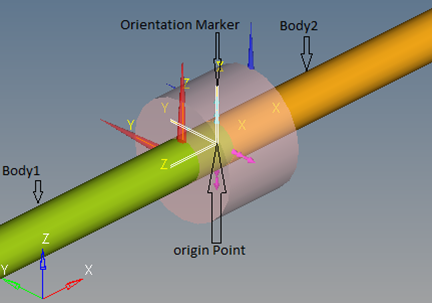Attach a Bushing to the Model
This section describes how you attach a bushing to a model.

Figure 1.
View new features for MotionView 2022.2.
Learn the basics and discover the workspace.
Discover MotionView functionality with interactive tutorials.
MotionView is a general pre-processor for Multi-body Dynamics.
Explore the MotionView menus which provide access to the various wizards, dialogs, tools, and panels.
The Project Browser allows you to view the MotionView model structure while providing display and editing control of entities.
Explore the various panels and tools in MotionView.
MotionView supports the importing of several types of CAD and FE formats.
MotionView has many pre-processing and post-processing capabilities with regards to flexible bodies, or flexbodies, for multi-body dynamics models.
Solvers and translators supported in MotionView.
Explore the various vehicle modeling tools.
The AutoRider models the mass and inertia of a human body and includes graphics for the human body.
The AutoBush is a bushing model that is designed to easily simulate bushings used in ground vehicles. The AutoBush entity reads bushing stiffness (force-displacement) and damping (force-velocity) data from a file written in the TeimOrbit format.
This section provides information about using the Altair Bushing Model, also known as AutoBushFD, with MotionView. The Altair Bushing Model is a sophisticated model that you can use to simulate the behavior of bushings in vehicle dynamics, durability and NVH simulations.
The Model Identification Tool (MotionView) is a utility in HyperGraph that you use to fit experimental data to various bushing models. The MotionView generates a General Bushing System file, .gbs file, which defines the bushing properties.
You can add an Altair Bushing Model, also known as AutoBushFD, a frequency-dependent bushing, to your MotionView model using the Add Auto Entity tool in MotionView.
This section describes how you attach a bushing to a model.
The Properties window includes five tabs that you can use to define the properties of your bushing.
In addition to adding a single bushing to your project, you can also add a pair of bushings such as AutoBushFD pair. When you add a pair, MotionView automatically reflects modifications you make on the left bushing of the pair to the right bushing, unless you choose otherwise. MotionView assumes bilateral symmetry about the global X-Z plane.
The AutoDamper entity is a force-velocity model designed to easily simulate a shock absorber used in ground vehicles. The AutoDamper entity reads force-velocity data from a file written in the TeimOrbit format.
Discover optimization with MotionView, MotionSolve, and HyperStudy.
Use the FMU tool to add a Functional Mock-up Unit and connect it to a multi-body model.
MotionView supports a limited version of interface with HyperWorks Collaboration Tools.
Reference material for the HyperWorks Desktop scripting interface which is a set of Tcl/Tk commands.
Reference materials for the MotionView MDL Language, Tire Modeling, and the MDL Library.
Reference material detailing command statements, model statements, functions and the Subroutine Interface available in MotionSolve.
Reference material for Templex (a general purpose text and numeric processor) and additional mathematical functions and operators.
Reference materials for the MotionView Python Language.
MotionView help for HyperWorks.
Explore the various vehicle modeling tools.
This section provides information about using the Altair Bushing Model, also known as AutoBushFD, with MotionView. The Altair Bushing Model is a sophisticated model that you can use to simulate the behavior of bushings in vehicle dynamics, durability and NVH simulations.
This section describes how you attach a bushing to a model.
This section describes how you attach a bushing to a model.

© 2022 Altair Engineering, Inc. All Rights Reserved.
Intellectual Property Rights Notice | Technical Support | Cookie Consent